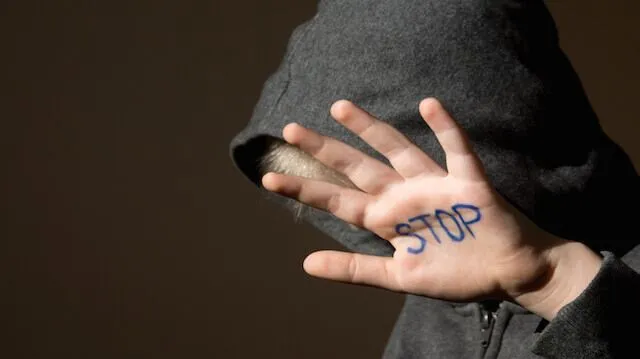
- Share on Facebook59
- Share on Pinterest
- Share on Twitter
According to the U.S. Department of Justice website, “Children exposed to violence are more likely to abuse drugs and alcohol; suffer from depression, anxiety, and posttraumatic disorders; fail or have difficulty in school; and become delinquent and engage in criminal behavior.”
Four out of ten children exposed to violence
The findings of the National Survey of Children’s Exposure to Violence revealed that approximately four out of 10 kids and teens in America are exposed to violence or abuse as either a victim or witness.
“Children are the most victimized segment of the population,” says lead researcher David Finkelhor of the Crimes Against Children Research Center at the University of New Hampshire. “They are more exposed to violence in the household than adults are. Kids who grow up in abusive families think that it is normal.”
Details of the survey were published in the June 29, 2015, edition of JAMA Pediatrics. In conducting the survey, over 4,000 children under the age of 17 were interviewed by phone. Topics of the interviews included child maltreatment, conventional crime, sexual assault, as well as peer and sibling abuse.
37 percent of children had been physically assaulted
Researchers found of the children interviewed, 37 percent had been physically assaulted during the previous year, with nearly 10 percent suffering an injury as a result of the violence.
“The full burden of this tends to be missed because many national crime indicators either do not include the experience of all children or don’t look at the big picture and include all the kinds of violence to which children are exposed,” said Finkelhor.
“You hear things like, ‘My dad used to whip me and I turned out fine,’ but we’re finding that often those people have places where they really are damaged,” said Finkelhor.
Abuse during childhood physically alters DNA
A separate study conducted by Duke University discovered that the DNA of children underwent serious changes when they had suffered abuse. The telomeres at the ends of the children’s chromosomes were shortened after exposure to violent abuse. The effects of these DNA changes are equal to between seven and 10 years of premature aging.
The telomeres act much like a plastic tip on a shoelace — they prevent the unraveling of chromosomes. With each division of a cell, they are shortened until they cannot shorten anymore, then they die. Many factors in life can cause telomeres to shorten, such as radiation, smoking, and serious psychological stress like childhood maltreatment.
The Duke University study found that kids who had been exposed to more than one type of violence underwent faster shortening of their telomeres than peers. These kids were then at an increased risk for age-related diseases like memory loss and heart attacks up to 10 years before their peers.
More proof toxic stress is terrible on health
Researchers did say there was hope for these children. In some cases, telomeres can lengthen when people learn to reduce stress, eat a diet of better nutrition, and regularly participate in exercise.
“We know that toxic stress is bad for you,” said Nathan Fox, a professor of human development at the University of Maryland, who was involved in a similar 2011 study. With regards to his research he said, “This paper provides a mechanism by which this type of stress gets ‘under the skin’ and into the genes.”
Indirect violent exposure is a problem too
The Finkelhor study also inquired about indirect violent exposure and discovered important insights.
“The study recorded those being called names, being told they are not wanted, being constantly told that they are incompetent,” said Finkelhor. “This includes having stigmatizing references made about them in terms of their looks or weight or sexual orientation or anything like that. These are the things that are destroying their prospects for the future and leading to later mental health problems.”
Finkelhor added, “Violence and abuse in childhood are big drivers behind many of our most serious health and social problems. They are associated with later drug abuse, suicide, criminal behavior, mental illness and chronic disease like diabetes.”
Many perpetrators of violence are caregivers
Another important reveal of the survey involved the perpetrators of violence. The interviewers asked children who committed the direct or indirect act of violence. They found that 15 percent had been maltreated by one of their caregivers. Also, six percent of children had been a witness to violence committed between their parents.
“This issue is one of the strongest predictors of both health and later-life social problems of anything that we have,” reported Finkelhor. “Exposure to abuse and violence in your childhood is associated with chronic health problems like diabetes and heart disease. But it is also associated with drug and alcohol abuse, anxiety, and other mental health issues.”
Fighting back against childhood exposure to violence
In 2013, UNICEF launched an initiative called #ENDviolence to promote public awareness and unity that “violence against children can no longer be tolerated.”
The following are the objectives of #ENDviolence:
- Alerting the public that children are exposed to violence everywhere.
- Engaging the public to take action to prevent children from being exposed to violence.
- Bolstering cultural and social attitudes to encourage non-violence.
- Fostering inspiration for new methods to prevent violent acts.
Though childhood exposure to violence is still an ongoing problem, the #ENDviolence initiative has already shown some impressive results in the two years since it launched:
- Over 20 million impressions have been made on Facebook.
- Over 70 countries around the world have formally become a participant in the initiative, taking a role in reporting and tracking all forms of violence against children.
- Significant growth in violence prevention programs.
 “Violence begets violence. We know that a child experiencing abuse is more likely to see violence as normal, even acceptable… and more likely to perpetuate violence against his or her own children in the future. If the trauma for children of societal violence is not addressed, we open the door to problems that can last a lifetime… and spawn negative attitudes that can reverberate across a generation,” stated UNICEF Executive Director Anthony Lake.
“Violence begets violence. We know that a child experiencing abuse is more likely to see violence as normal, even acceptable… and more likely to perpetuate violence against his or her own children in the future. If the trauma for children of societal violence is not addressed, we open the door to problems that can last a lifetime… and spawn negative attitudes that can reverberate across a generation,” stated UNICEF Executive Director Anthony Lake.
“The more adverse experiences in childhood, the greater the likelihood of developmental delays and later health problems, including heart disease, diabetes, substance abuse, and depression. Research also indicates that supportive, responsive relationships with caring adults as early in life as possible can prevent or reverse the damaging effects of toxic stress response,” reported the Center on the Developing Child, Harvard University in the report Key Concepts: Toxic Stress.
Strategies for preventing and responding to childhood exposure to violence
According to UNICEF, there are six successful strategies for preventing and responding to violence against children:
- Using education methods to support caregivers, parents and families about early childhood development and the need for positive methods of discipline and communication.
- Using education to teach coping mechanisms to children and teens for dealing with risks and challenges without resorting to violence. Encouragement to seek appropriate support when violent exposure has occurred.
- Working towards changing cultural and societal acceptance of discriminatory and violent behaviors.
- Creation, implementation, and enforcement of policies and regulations to protect children from violence.
- Continuing to collect and report information on violence, where it occurs, and other relevant data helps researchers to continue planning and developing strategies for intervention.
Helping children to learn positive behaviors
Research has shown that violent behavior is learned and repeated even early on in life. However, good behaviors can be learned just as easily as violent ones. Important things to remember when dealing with children:
- It is extremely important to provide proper emotional support for children to feel safe and loved.
- Children learn a great deal by observing the actions and behaviors of others. This observational learned behavior does not just include caregivers and siblings, but also programming on television, movies, and videos.
- Even just witnessing an act of violence is harmful to children, particularly when family members or other loved ones are involved. Positive role modeling and healthy interactions are very important to a child’s development.
- Children need healthy coping mechanisms to help them understand emotions like anger. It is important for children to learn that it is okay to be angry, but to express that anger in ways that can be productive instead of destructive.
It is critically important to realize how devastating exposure to violence can be for children. Please take a pledge against violence, and do your part to help prevent domestic abuse and bullying. Ask around your community to find out if there are violence prevention programs looking for volunteers, and if not, consider starting one up.
—The Alternative Daily
Sources:
http://www.reuters.com/article/2015/06/29/us-usa-violence-kids-idUSKCN0P91YS20150629
http://archpedi.jamanetwork.com/article.aspx?articleid=2344705
http://www.jaacap.com/article/S0890-8567(09)63758-8/abstract?cc=y=
http://www.justice.gov/defendingchildhood/facts-about-children-and-violence
https://www.ncjrs.gov/pdffiles1/ojjdp/227744.pdf
http://www.takepart.com/article/2015/07/04/poll-violence
http://www.ncbi.nlm.nih.gov/pmc/articles/PMC3869039/
http://usatoday30.usatoday.com/news/health/story/2012-04-24/violence-cellular-mark/54493338/1?fullsite=true
http://www.unicef.org/publications/files/Ending_Violence_Against_Children_Six_strategies_for_action_EN_2_Sept_2014.pdf
http://actagainstviolence.apa.org/resources/psa/violence-prevention-families.pdf
- Share on Facebook59
- Share on Pinterest
- Share on Twitter

